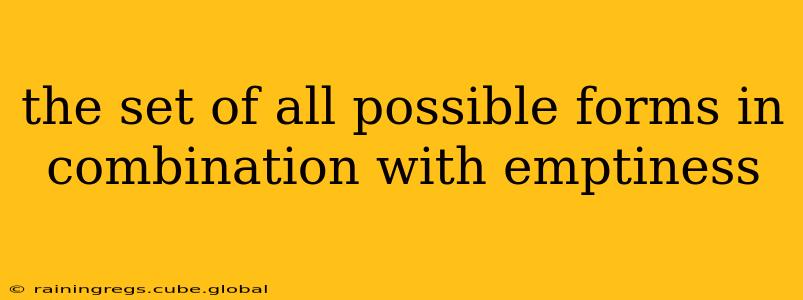The Set of All Possible Forms in Combination with Emptiness: Exploring the Concept
The concept of "the set of all possible forms in combination with emptiness" is a profound one, touching upon philosophical, mathematical, and artistic realms. It transcends simple definition and invites exploration from multiple perspectives. This exploration delves into the essence of this concept, addressing common questions and providing a nuanced understanding.
What is meant by "forms"?
The term "forms" in this context can encompass a multitude of interpretations. In philosophy, particularly within Platonic thought, forms represent ideal, unchanging archetypes of objects and concepts. A perfect circle, for instance, is a form – every circle we draw in the physical world is merely an imperfect manifestation of that ideal form. In a more general sense, "forms" can refer to any kind of structure, pattern, or shape, both tangible and intangible. This includes physical objects, mathematical equations, musical compositions, social structures, and even abstract ideas.
What is meant by "emptiness"?
"Emptiness" is equally multifaceted. It's not simply the absence of something, but rather a state of potentiality, a void brimming with possibilities. In Buddhist philosophy, emptiness (śūnyatā) refers to the lack of inherent self or independent existence. Everything arises in dependence upon other things, and this interconnectedness constitutes its reality. In a more general context, emptiness can represent the absence of defined form, a lack of structure, or a blank canvas awaiting creation.
How do forms and emptiness interact?
The interplay between forms and emptiness is dynamic and central to the concept. Forms emerge from, exist within, and ultimately return to emptiness. Think of a sculptor working with clay: the clay represents emptiness, a formless potential. Through the sculptor's actions, forms are created, but those forms are still fundamentally clay, still bound to their origin in emptiness. The forms exist only in relation to the emptiness from which they arise and to which they eventually revert. The emptiness isn't passive; it's the fertile ground from which all forms spring forth.
Can we define the "set" of all possible forms?
Mathematically, defining a "set of all possible forms" is a challenge. The concept may invoke Cantor's Paradox, highlighting the limitations of set theory when dealing with sets of unlimited size and complexity. While we cannot definitively define such a set using formal mathematical language, the concept serves as a powerful thought experiment, prompting us to consider the limitless possibilities inherent in the universe.
Is it possible to visualize the set of all possible forms in combination with emptiness?
Visualizing this is practically impossible. It transcends the limitations of our sensory perception and cognitive abilities. However, abstract art often attempts to grapple with such concepts, conveying a sense of the formless, the potential within the void, and the ephemeral nature of form. Think of minimalist sculptures or abstract paintings that suggest rather than explicitly define. These works often rely on the viewer's own interpretive processes to fill in the gaps, to bring meaning to the void.
What are the implications of considering this concept?
The concept of all possible forms in combination with emptiness has profound implications across various disciplines. In art, it encourages exploration of new forms of expression and a deeper engagement with the creative process. In philosophy, it compels us to question the nature of reality, existence, and the relationship between being and non-being. In science, it can inspire research into the fundamental building blocks of the universe and the processes by which complexity arises from simplicity.
Ultimately, "the set of all possible forms in combination with emptiness" is not a concept easily defined or fully grasped. It is a boundless, ever-evolving idea that invites constant exploration and reinterpretation. It highlights the interconnectedness of existence and the infinite creative potential residing within the seemingly empty void.
